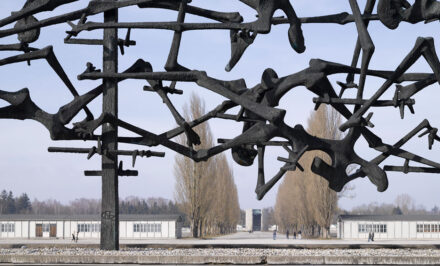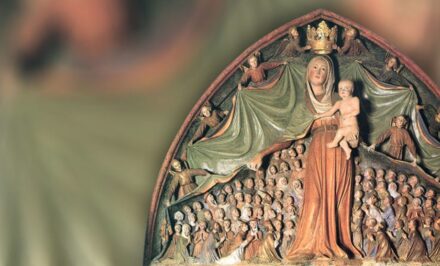Dr. Martin Flesch, Germany •
Notes from a Psychiatrist on the Clarification Process in the “Cause of Kentenich”. A system-analytical essay. —
I The “and” is crucial – it protects us from the “either-or”!
Thomas Merton
Since July 2020, the topic of the so-called “Cause of Kentenich”, which has been constantly present in the thoughts and feelings of not just a few Schoenstatters, forces with time everyone who makes an effort in the sense of their own personal clarification to confrontation and debate, to discussion, and finally, as far as at all possible, to their own positioning.
Analyses of the reactions have been going on since the publication of the book “Father can do that! (by the church historian Alexandra von Teuffenbach, published by Bautz). Emotional upsurges, protest attitudes and demonstrations of understanding, which could also be described – with a wink – as the beginning of Schoenstatt’s process of clarification, allow a closer look to illuminate a phenomenon that unfortunately seems to be abused all too often in church-related committees and shows in the sense of de-escalating processes understood in this way. Herein, the phenomenon of dualism is can be seen.
Dualistic basic attitudes and discussion approaches usually represent an “either-or” attitude, they see “black-or-white”, mean “good-or-evil”, and clearly lack the “as-well… as”, which is so crucial for a solid clarification process within the framework of the solution approaches that are then developed.
The fact that the predominantly dualistic basic attitude in the reactions and damage limitation efforts of the entire Schoenstatt Movement, which have often seemed helpless since the publication of the book, has not only already drawn wide circles, but has also produced and is still producing not inconsiderable collateral damage, can – regrettably – easily be shown with not just a few examples from a psychodynamic, or if you will, from a socio-psychological perspective:
II Appreciation through devaluation? – The “and” allows us to always appreciate both sides and criticize both sides
Since the beginning of the emotional upsurge around the “Cause of Kentenich “, not a few persons or personalities from the former environment of Father Kentenich reached an individual appreciation and such a degree of fame, which at first makes one wonder. On closer examination, however, it becomes clear that the supposed interest originally shown does not at all seem to apply to the concrete individuality or the actual personality of these persons who are the focus of attention, but instead refers to an intersection that unites all the people cited in this way to one focal point: they stand in a discursive relationship to Joseph Kentenich, they dared to criticize him or the methods he used, and they fell outside the self-understanding of Schoenstatt practiced at that time.
The analysis of the contemporary testimonies, written testimonies and documents available about these persons now points to a practice that is unfortunately often observed in Schoenstatt circles. This tendency has been noticeable both with regard to Schoenstatt practices and to Joseph Kentenich’s behavior and not only since the publication of Ms. von Teuffenbach’s book in July 2020. It seems to be the case that the critical appraisals that emerge from the testimonies of the persons thus discussed seem detrimental to a founder image that has been striving for and defending a degree of so-called “holiness” since 1968. This could call into question a degree of “holiness” (whatever this attribute may mean) that has been strived for and defended since 1968.
However, it must by no means be disregarded at this point that these statements, on the other hand, naturally contradict the fact that quite a few people elsewhere have received personal and very valuable impulses from the person of Father Joseph Kentenich and the spirituality of the Schoenstatt Movement as such. These statements, too, are to be integrated into the contradictions arising here according to a fundamentally tolerant overall approach.
The persons thus endeavored refer, for example, to Sister M. Anna, Sister M. Agnes, Sister M. Georgia, Sister M. Gregoria, Father Heinrich M. Köster as well as Father F. Schmidt, to mention only a few names here.
Of course, it is by no means ignored that the respective (critically held) statements of the aforementioned persons, as also documented in such a way with Ms. von Teuffenbach, trigger critical questions with the readers informed concerning the historical context. Again, it is necessary to accept the paradox that is shining at the moment and to integrate it into the overall approach.
The subsequent Schoenstatt handling of these personalities, both in the past 50 years, but especially since the year 2020, however, from a psychiatric and psychopathological point of view not only leaves one in disbelief, but generates in the skilled observer a reaction to these procedures bordering on incomprehension and rejection and more than questioning, which absolutely raises the need for further discussion.
To be quite clear, it can undoubtedly be observed in the course of time that men and women who are critical of the person of Father Joseph Kentenich are pathologized in a way that belies any psychological, psychopathological and professional psychiatric competence, insofar as in this context technical terms were and are used that contain a pathologizing evaluation, without the necessary care being taken with regard to phenomenological perception and subsequent classification and attribution according to the internationally valid diagnostic systems.
It can also be observed that from certain branches of the Movement, so-called “information and lecture evenings” are organized and held, which ultimately pursue no other result than to certify the persons stigmatized in this way as having socio-psychological deficits, communication and personality deficits, and not least also mental illnesses, which are intended to correspondingly limit or even nullify their ability to judge and criticize and to participate in the context of Schoenstatt history. This procedure and the readiness for just this basic attitude is not only to be condemned from a professional psychiatric point of view, but should certainly have no place (anymore) within a movement that attests to its founder a “holy life”.
In this context, it is certainly understandable – also from a psychiatric perspective – on the one hand, that these so-called information and educational events are based on comprehensive research of the available archival material, but on the other hand, they reveal a clear tendency to possibly show the problem in focus too one-sidedly rather to the detriment of the persons mentioned.
Regrettably, in this context one hears and reads about “schizophrenic behavior,” “female hysteria,” “sick striving for recognition,” “psychological compulsion” and “antisocial natures. It is doubtful, however, that the speakers using these terms are even aware of the damage they are doing to the contemporary witnesses in question by psychiatrizing, pathologizing and attributing them. In extreme cases, one could even hear the terms “traitor” muttered if one followed the development of the discussion carefully. It needs no further discussion to put the question into the room whether this practice of the process clarification of a faith movement is worthy!
III Man or saint? – The “and” helps us to see and accept the dark side in us
On the way of our continued analytical consideration, the analysis of the history of the beatification process of Father Kentenich inevitably leads to a basic insight that certainly cannot be questioned: Joseph Kentenich was first of all a man of flesh and blood. Just like us, he went through his early childhood, childhood, and adolescent phases of development, at the end of which stood the adolescent, the young adult, and finally the mature personality of Joseph Kentenich. The breaks in relationships, voids, crises and departures that had to be overcome along the way formed the extraordinary personality structure of a man who not only survived serious existential crises of meaning, imprisonment and several years in the concentration camps, but also made these times fruitful for his faith movement. The role played by divine grace in this process will not be discussed here as a matter of priority.
The recognition that we are dealing first of all with a human thinking, feeling, acting and believing individual naturally and necessarily also leaves room for the acceptance of varieties of human states of being and character traits which, within the framework of their effectiveness on the level of action, naturally also include conflictual peaks and developments in dealing with fellow human beings, the entrusted and brothers and sisters in faith. No one is perfect and flawless in his or her actions and words, despite constant striving and effort on the basis of the talents and abilities given to him or her. The responsibility given to Joseph Kentenich for the foundation and leadership of a worldwide faith movement with numerous members naturally entails that within the leadership tasks, there will also be wrong decisions, inadequate reactions or the misjudgement of people; this is within the realm of the normal (“just the way people are”).
It is precisely these – at least not excludable – personality traits of the founder Joseph Kentenich that are now being pointed out in the most recent publications, thus generating a more than irritating and turbulent reaction in the Schoenstatt area. Many Schoenstatters now see the process of beatification, which has been dragging on for a long time, endangered. The author’s objections, which are admittedly to be viewed in a very differentiated and critical way, do indeed lead to the question of which personal limits existed for Joseph Kentenich and how these affected his actions and his movement.
How could these sometimes very violent and sometimes inadequate counter-reactions have come about in the first place?
Was it seriously assumed that a person like Joseph Kentenich did not possess normal psychological reactions and characteristics, or could he simply not have possessed them, because he consequently no longer corresponded to a projection field, which apparently numerous members of the movement claim (need) for themselves?
Rather, the impression arises that the “humanization” of the founder created by the publications leads many Schoenstatters concerned and fearing that they will have to live with a different image of the founder in the future. This image no longer satisfies their own faith, hopes and attributes which have been projected onto the founder. The fact that coping mechanisms, such as negative feelings of fear, anger, rage and sadness, are set in motion is also understandable and inferable from a normal psychological point of view.
At this point, the interjection should be noted that the Movement already went through a similar process of clarification and reappraisal about 30 years ago, namely, in the context of the disclosure of Joseph Kentenich’s illegitimate origins, which, however, had ultimately led to a deeper understanding of Joseph Kentenich’s personality.
This process in the Movement, which was already positively mastered 30 years ago, could therefore represent a clear resource in the collective experience, in order to face the current challenges of a more differentiated view of the personality image of Joseph Kentenich.
But one should not remain on this level. The extraordinary life work of Joseph Kentenich as well as his life achievement are at no time in question. It is advisable to finally abandon the dualistic approach of argumentation that only a “saintly” imposing founder, who thus appears historically without fault or blame, can develop a corresponding after-effect that outlasts the times.
At this point, the undersigned does not, of course, ignore the fact that the most recent publications also deal with aspects of abuse, as well as the question of whether Joseph Kentenich’s actions, which come to bear in the context of the contemporary testimonies, corresponded to these (phenomenological) criteria.
The accusations against the founder, which are now in the room, of having fulfilled the aspects of abuse and sexualized violence in the said periods, are currently being worked through within an objective clarification process. In an interview with the Trier church newspaper, the Bishop of Trier recently commented on the reasons for wanting to convene a group of experts instead of a commission of historians, as initially announced. The reason given was that the new procedure would allow greater freedom in the working method. Together with the commissioners, it would now be possible to define various work assignments relating to historical, psychological or pedagogical aspects. It would then be possible to compare and discuss intermediate results and, above all, to deal openly with the results.
However, the Bishop of Trier also discussed that his motivation for the so-called action was respect for possible victims, whose accusations he took seriously.
IV Principle loyalty (statute constraint) or compassionate empathy?- The “And” does not trust any love that is not justice at the same time
The – by the Bishop of Trier – so formulated “respect for possible affected persons, whose accusations are to be taken seriously” – in the context of a further developmental step of our discussion, directs the focus away from the founder, rather towards the presently living and working members of the Schoenstatt Movement:
In the meantime, women and men who have revealed themselves and who live in the present time feel unpleasantly reminded of manners that were shown to them as affected persons by Schoenstatters within their branch of the Movement from the events within the “Cause of Kentenich”. In particular, these so-called “affected persons” recognize for themselves frightening parallels, namely between the discrediting of people who lived and worked in Joseph Kentenich’s former environment and who expressed themselves critically (as described) and the standards of communication and evaluation that have been applied to them in the last 20 years. These are primarily individual persons affected by the various branches who had to make these experiences in their respective contexts and who communicated these experiences within the framework of the undersigned’s counseling activities within his practice, while maintaining medical confidentiality. However, from a therapeutic perspective, it must also be emphasized that the aim in this context tended not to discredit “critics”, but rather to catch the psychological suffering subjectively felt by those affected in their own contexts thus named and to bring it to a linguistic level (not least also a task of psychiatrists and psychotherapists).
In other words, the people thus designated as “affected” feel hurt, devalued, humiliated and – unfortunately this term must be used – actually concretely traumatized by very similar actions within the movement.
Within the framework of the process of clarification within the Movement that is now underway, on the basis of the “Cause of Kentenich”, it is therefore high time to reflect on empathetic, compassionate, but above all on transparent and openly truth-seeking forms of interaction in the branches of the Movement, which neither restrict the freedom of the members of the Movement branches who (still) feel called, nor push them to the brink of existential and serious psychological crises. At this point, there is inevitably a call for much more self-care, for a willingness to turn to the individual surrendered person with all the commitment of charitable, pastoral and Jesuan care, and – finally – it must be emphasized again – to say goodbye to the platform of a dualism in the movement that has become unbearable.
VProgression or conservative encrustation? – The “and” helps us to live in the eternally imperfect now
With all understanding for the goal-oriented conclusion of the “Cause of Kentenich”, it remains to be said that the current external effect of the movement will never be measured exclusively by how much energy, time, commitment and lifeblood was invested in the reappraisal and final presentation of the founder’s personality.
It is understandable that at the moment numerous resources must be taken up through all movement branches. However, the sensitivity for the time currents, for the signs of the times, which suffers from this, should not experience any further restrictions. The many hardships and social misery of the present time are just around the corner and are waiting to be remedied or to find solutions. Is Schoenstatt currently moving on this level of the times? Or is there not a danger that numerous resources could be dualistically and narcissistically tied up by a process that overshadows everything – which certainly must also take place? Certainly not overlooked are the forward-looking efforts, such as the commitment in the family academies, the “Pastoral care on the pulse “, the impressive projects in youth work (especially during the Corona pandemic). Nevertheless, we should face the aforementioned questions constructively:
Do we have answers to the social grievances, do we have answers to offer to the migration movement (80 million refugees worldwide), and do we as a current faith movement of the newest time (Kentenich) also have our ear to the pulse of time? Do we have answers to the European Union’s policy of exclusion of refugees, which is contemptuous of human rights, do we have charitable answers to the social housing shortage in our country, do we have answers to the widening gap in wealth, do we have charitable, pastoral and pastoral solutions for those who are searching, those who have been uprooted, those who have been traumatized – do we see the marginal figures of our society, do we care about them?
There are already extremely good approaches and committed projects that deal with the accommodation and accompaniment of refugees, especially in the centers run by the Schoenstatt Sisters of Mary in Herxheim and Borken, for example. The “Action light signal ” (for mothers in need) and the charitable projects on Belmonte should also be mentioned.
Nevertheless, if we claim to want to confront the contemporary currents in a transparent, solution-oriented and empathetic way, we must also ask ourselves to what extent we are prepared to deal with these very currents and developments, also in phenomenological terms, and their contents in an equally open and transparent way. In the end, it is of little help if – as has unfortunately been repeatedly claimed within the movement – initiatives are launched that are supposed to work towards concrete neglect of precisely these activities of confrontation (“reading ban” of the most recent publications by Ms. von Teuffenbach).
How is a competent, transparent discussion at eye level supposed to look if members of the movement – entrusted with leadership functions – set in motion an effort to not take note of documents that are the subject of the proceedings in the first place? In this context, there can alos only be a persistent warning against a creeping progressive dualism. Whereby here of course , one cannot overlook that people could not get into the archive in Limburg for a long time as well as the circumstance that more intensive research became impossible- also in the archives in Rome – naturally due to pandemic.
VIIt’s time… to listen to the soul(s)…!
It is time that we face up to such a clarification process. However, anyone who merely proclaims this content and fails to put them into practice will at some point find himself in a scenario that has fallen out of time and whose structure will then only present a distorted image of the former reality. They will no longer have anything in common with the new departures associated with the currents of the latest era.
Let us dare to speak openly to each other – without the still palpable fear of consequences and loss of face “at every corner and ends” – to present our opinion, to listen to the perspective of the other, to weigh up arguments. Let us also say “yes” to the dark sides and parts, let us have the courage to integrate them. The human existence, the being-forms of the human soul and the lasting psychic stability are not compatible with dualism in the long run.
Let’s say goodbye to dualistic and narcissistic structures, which are bound to the urge for recognition, and let’s look forward to the future together in a tolerant, empathetic and dynamic way!
The willingness to think about these steps is the first step out of dualism and the first step into the tolerance of “and”.
We will not be judged by our ability to integrate only the day after tomorrow!
The particular form of everyday spirituality that emerges from the Schoenstatt Movement, within the framework of its preservation and conservation, can never reflect only its own end in itself. Especially, if it wants to keep in view the concrete salvation of souls and the accompaniment of our soul parts filled with longing.
Certainly, we have very different forms and practiced structures within the movement in the individual branches, whose diversity and self-imposed nature is not misjudged at this point. But – excessive hierarchical structures, the revelation of narcissistic needs, the serving of projection fields to an unhealthy degree, the formation of opinion camps as well as sometimes resulting from this exclusion, demarcation, offenses and rejections, up to concrete lasting soul injuries (which in the worst case can grow into traumatization) also show us that we must take care of these soul structures here and now, but also in the medium to long term, also in Schoenstatt, and also in our Movement.
Therefore, let us acknowledge the “marginal structures”, let us avoid dualism and particularism, let us also give a chance to the “other” in us, but also in our counterparts.
When the individual soul is sick, the whole structure of movement is also sick
On the basis of the opening quotation of the present contribution, a path-breaking and comprehensively integrating arc of tension of our discussions thus closes at the end – despite all paradoxes. There are sufficient occasions and signs of the times to leave behind us dualistically shaped levels of conflict and to look hopefully into the newest time:
In doing so, we have decisive guidelines at our disposal; all we need to do is pick them up and use them creatively:
Let us keep in mind the personality of the founder, let us appreciate his life’s work and his charitable activity, but let us also allow reflections and analyses of his personality, which can show the limits of his personality structure.
Secondly, the work of God in history remains unbroken (of course). Here, it is still necessary to analyze the signs of the times constructively. Also God works with paradoxes, which the human being often only with difficulty endures. Often, however, the “as well as – and – also” proves to be more purposeful and integrating, the “either-or” dissolves on the basis of his standards in not few cases conflict-distorting.
Ultimately, however, the salvation of the soul of the single individual, of the single very concrete person, is always in the foreground of all considerations and dedicated efforts (this should at least be the basic therapeutic approach of every psychiatrist, psychopathologist and therapist). The adequate dealing with mental structures, with mental suffering and life and the dynamics connected with it should give us the maxim of action. Let us follow this path!
The undersigned considers it possible, and by no means rules it out, that through his willingness to publish this essay on the platform here (schoenstatt.org), he will be tendentiously assigned to a very specific focus of opinion by not just a few readers from the Schoenstatt Movement. Should this be the case, it would be further proof of the method of dualistic assessment discussed and critically evaluated in this article, as well as of the fact that dualistic tendencies tend to promote a constantly narrowing particularism.
Veitshöchheim (Franken), March 2021
Dr. med. Martin Flesch
Doctor of Psychiatry- Psychotherapy- Forensic Psychiatry
Original: German, 03/23/21. Translation: Lindsay Burger, Ohio, USA














